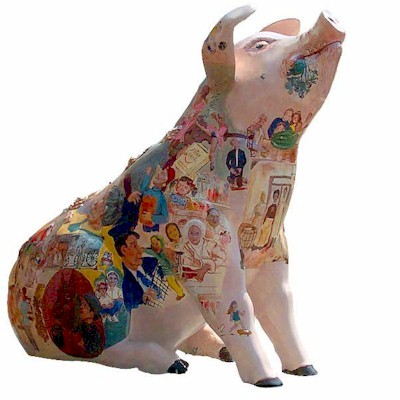

| Back to Animals Gallery page |
I used Magic Sculp to make relief sculpture on
the back and sides of the fiberglass pig I had to do for the
Cincinnati Big Pig Gig.
www.bigpiggig.com.
Ham Salad BY Mary Ann Reed
People smile about the idea of a "Big Pig Gig." But
Cincinnati would not be the city it is without pigs.
Early in the 19th century farmers in the country surrounding the city raised pigs and corn, a combination that produced excellent
meat and livelihood for the many German people emigrating to the city. By the 1820s, the bustling port of Cincinnati made it
possible to transport pork more rapidly to consumer markets. Cincinnati businesses sprang up around the pork-packing industry.
It was not uncommon for pigs to be herded through the streets in the 1830s and 1840s. They were smelly and made a mess of
the streets. Visitors were often shocked, but Cincinnatians grew used to them, erecting sturdy wrought-iron fences to keep the
pigs off their city properties.
So much of the meat came from Cincinnati that the city began to be jokingly called "Porkopolis." In 1835 the city was
the leading meat-packing center in America. By 1845 it led the world.
The pork-packing industry led to other new businesses. Hog bristles were used in plaster and to make brushes, mattresses and
furniture. Tanneries used hides to make boots, shoes and saddles. Pork fat was used to make lamps oil and candles.
A candle-maker, James Gamble, partnered with businessman William Procter in 1837 to use pork fat to produce a high-quality soap
and sell it in small blocks. From those humble beginnings grew the Procter & Gamble Company, one of the largest consumer
product manufacturers in the world today.